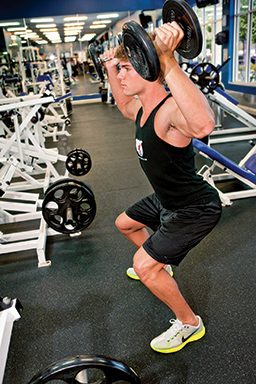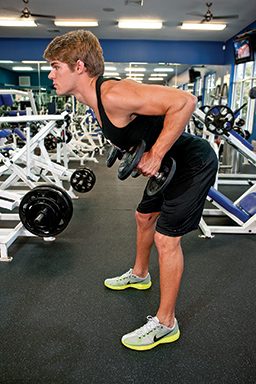Lower-body muscular strength (how much you can lift) and endurance (how long you can continue to lift) are necessary for scuba diving. On land, a full set of scuba gear weighs about 30 pounds, so the stronger your lower body, the easier you can rise from a bench for entry and climb a ladder during exits.
Here we target the large muscle groups responsible for moving the knees and hips (quadriceps, hamstrings, gluteals). Our lower-body workout features two exercises you may already know: squats and good mornings. As usual, these exercises require minimal equipment and can be performed virtually anywhere. They also activate your core abdominal and lower-back musculature to improve balance and stability.
Performing squats is similar to rising from a chair without the use of your upper body. To execute good mornings, bend at your hip while you keep both feet on the ground. Due to their positive effects on large muscle groups, these are good all-around exercises for novices and Olympians alike.
NOTE: Strenuous exercise following a dive may increase the risk of decompression sickness. DAN recommends divers avoid exercise for 24 hours after surfacing.
Building a Balanced Program
As with previous workouts presented in this column, the best results come from working agonist/antagonist muscle pairs to achieve overall fitness. Squats work the front leg muscles (quadriceps), while the good mornings work the back leg muscles (hamstrings). Both exercises also activate muscles in the gluteal (buttocks) region.
Equipment needed: two dumbbells. In a pinch, you can even use your dive weights.
The routine: In sequence, perform eight to 12 squats followed by eight to 12 good mornings. Repeat three times, adding challenges/adaptations as you feel comfortable. Allow only minimal rest between sets. Keep your core muscles engaged throughout the sequence by pulling your belly button toward your spine and maintaining a flat back.
Begin all exercises in an athletic stance with your feet a little wider than shoulder width apart, knees slightly bent, chest out and shoulders back. To align your back, bring your shoulders up toward your ears as far as they will go, then roll your shoulders back.

Squats
Form: Hold the dumbbells above the shoulders. Keep your weight through your heels, training your eyes on the sky. Bend your knees while sticking your buttocks out until your thighs are approximately parallel to the floor.
Trainer Tips: A good way to learn how to squat correctly is to place a chair behind you; this allows you to feel comfortable while sitting back. You can also try leaning on a physio ball and rolling it down a solid wall with your back. If you can wiggle your toes during this exercise, your weight is being transferred correctly through your heels. Engage your core to maintain a flat back throughout the exercise.
Challenge: Try doing the squat on one leg at a time using only your body weight at first (no dumbbells). Make sure you keep your eyes to the sky and can wiggle your toes.
Good Mornings

Form: Start with elbows bent, holding dumbbells at your sides. Inhale while bending forward at your hips until your torso is parallel to the floor. Always maintain a flat back. Exhale as you return to the starting position by extending your hips.
Trainer Tips: Flexing your knees will make the hip extension movement easier. Do not use heavy weights for this exercise. You should feel the tension in the gluteal muscles in your buttocks, NOT in your back. Keep your chest out and shoulders back throughout this exercise.
Challenge: Try keeping your legs straight, but don’t lock your knees. This fully extends the hamstrings so you can feel them contracting.
© Alert Diver — Q2 Spring 2010